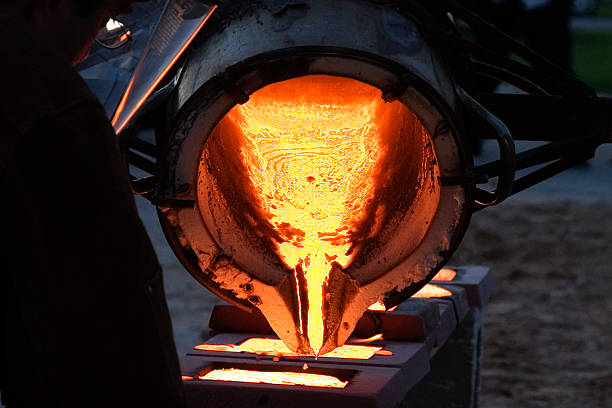
Gilsonite in Foundry Description
In the dynamic world of foundry operations, innovation is the key to achieving precision and efficiency in metal casting. One such innovation that has garnered increasing attention is the use of Gilsonite, a naturally occurring hydrocarbon, in various aspects of the foundry industry. In this comprehensive article, we will delve into the multifaceted role of Gilsonite in foundry applications. From its diverse uses to the advantages and disadvantages and its pivotal role in foundry sand, we will explore how Gilsonite is shaping the future of metal casting.
Application of Gilsonite in Foundry
- Binder for Sand Casting: Gilsonite can be mixed with molding sand to create a strong and resilient binder. It improves the cohesion of the sand, which is crucial for creating intricate molds in the foundry process.
- Core Sand: Gilsonite is often used in the production of core sand, which forms the internal cavities of metal castings. Its adhesive properties help maintain the shape and integrity of the core, even when subjected to high temperatures and mechanical stress during casting.
- Release Agent: In foundry applications, Gilsonite can act as a natural release agent, preventing the molten metal from sticking to the mold and facilitating easy removal of the finished casting.
- Reducing Veining: Gilsonite can reduce or eliminate veining defects in castings, which occur when the metal penetrates the sand molds due to high thermal expansion. Its unique composition helps minimize such issues.
- Sealant and Coating: Gilsonite-based coatings can be applied to foundry equipment and tools, providing protection against wear, corrosion, and heat.
Advantage of Gilsonite in Foundry
- Improved Sand Strength: Gilsonite significantly enhances the tensile and compressive strength of molding sand, leading to better mold stability and reduced defects.
- Enhanced Mold Durability: Molds and cores containing Gilsonite are less prone to erosion, ensuring they maintain their shape and integrity during the casting process.
- High Thermal Stability: Gilsonite can withstand extreme temperatures without breaking down, making it suitable for casting various metals, including those that require high pouring temperatures.
- Cost-Efficiency: When used as a binder, Gilsonite can reduce the overall cost of sand casting by requiring fewer additives and less maintenance of molds and cores.
- Reduced Environmental Impact: Gilsonite is a natural, non-toxic material, making it a more environmentally friendly choice compared to synthetic binders and additives.
ِِDisadvantage of Gilsonite in Foundry
- Limited Availability: Gilsonite deposits are not as widespread as some other foundry materials, which may limit its availability in certain regions.
- Handling Challenges: Gilsonite is typically supplied in solid form and must be heated to become malleable. Handling and processing this material can be challenging and requires appropriate equipment and safety measures.
- Cost Variability: The price of Gilsonite can fluctuate due to factors such as supply and demand, extraction costs, and geopolitical issues.
- Compatibility: Compatibility with other foundry materials and additives must be considered to ensure consistent and reliable casting results.
Benefits of Gilsonite foundry sand
- Reduces imperfections due to the rapid reaction between the silica sand mold and the oxidized surface of molten iron.
- Improves sand peel from casting at shakeout.
- Produce a smoother, cleaner casting surface.
- Minimize imperfections, casting losses, and scrap.
In Foundry and Refractories, for molding high-value metals there is more attention to factors such as finishing. Gilsonite can be a superior carbon additive replacing the traditional Sea Coal which has a low Carbonic value compared to Gilsonite Specifications.
Specification of Gilsonite in Foundry
| NO | TEST | RESULT | TEST METHOD |
|---|---|---|---|
| 1 | ASH CONTENT,WT% | 10 | ASTM-D3174 |
| 2 | MOISTURE CONTENT,WT | 0.5 % | ASTM-D3173 |
| 3 | VOLATILE MATTER,WT% | 64 | ASTM-D3175 |
| 4 | SOLUBILITY IS CS2,WT% | 78 | ASTM-D4 |
| 5 | SPECIFIC GRAVITY @25C | 1.11 | ASTM-D3289 |
| 6 | NORMAL NEPTHAN INSOLUBLES,WT% | 79 | ASTM-D3279 |
| 7 | COLOR IS MASS | BLACK | - |
| 8 | COLOR IN STREAK OR POWDER | BLACK | - |
| 9 | SOFTENING POINT,C | 150 | ASTM-D36 |
| 10 | PENETRATION @25C | 0 | ASTM-D5 |
Analysis
| NO | TEST | RESULT | TEST METHOD |
|---|---|---|---|
| 1 | CARBON,WT% | 78 | ASTM-D5291 |
| 2 | HYDROGEN,WT% | 7.1 | ASTM-D5291 |
| 3 | NITROGEN,WT% | 3.67 | ASTM-D5291 |
| 4 | OXYGEN,WT% | 3.1 | ASTM-D5291 |
| 5 | SULPHURE,WT% | 2 | LEGO(S)ANALYSER |

